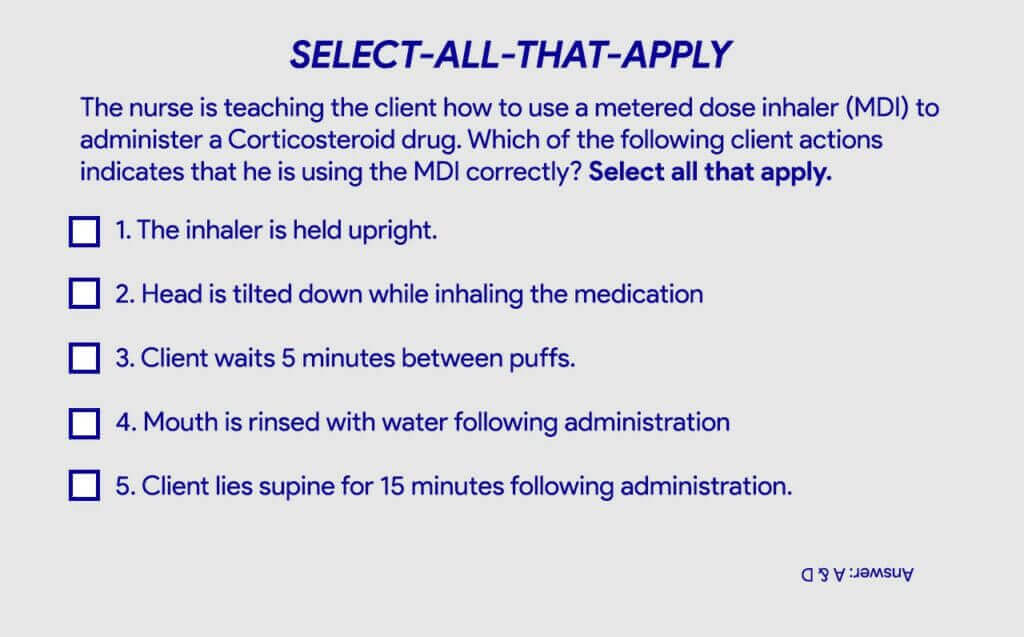NCLEX Select All That Apply Questions: Tips for Success
Are you struggling with Select All That Apply in NCLEX? In this guide, I’ll share some strategies I’ve learned from taking the NCLEX. SATA questions can be tricky, but with the right mindset and techniques, you’ll tackle them like a pro.
I’ll talk about how to really understand what each question is asking, avoid common mistakes, and pick the answers confidently. So, if you’re ready to boost your SATA skills and ace the NCLEX, let’s dive in and get started!
The Essence Of Select All That Apply Questions In NCLEX

The Select All That Apply (SATA) assesses nursing candidates’ critical thinking abilities and clinical judgment. SATAs evaluate your ability to recognize multiple correct options from a list of choices. SATA is also a main part of the various types of questions included in the NCLEX exam.
Format Of SATA
SATAs typically present a stem or scenario followed by a list of options. You must select all the options that apply to the given situation.
The options may include various nursing interventions, assessments, diagnostic findings, or therapeutic measures relevant to the scenario presented.
Example:
Stem: A 65-year-old patient with a history of hypertension presents to the emergency department with complaints of chest pain. Which of the following interventions are appropriate for this patient? (Select all that apply.)
In this example, you would need to identify all the appropriate interventions for managing a patient presenting with chest pain.
How To Distinguish SATA From Multiple-Choice?

While SATA and multiple-choice formats present options, SATA requires candidates to select all correct answers, while in multiple-choice questions, there is typically only one correct answer.
Regarding instructions in the question, multiple-choice questions usually instruct you to choose the best or most appropriate answer. SATAs explicitly state that the candidate should select all answers or a similar directive.
So, SATA questions tend to be more complex, requiring a deeper understanding of the content and the ability to identify multiple correct options.
What about scoring? In multiple-choice questions, you either receive full credit for selecting the correct answer or no credit for choosing an incorrect option. Yet, partial credit is awarded for selecting some correct options but not all in SATA questions.
Tips When Answering SATA Question
To answer SATA questions on the test, you must have a strategy. Here are the tips I follow for these types of questions:
Gain As Much Nursing Knowledge As Possible
Based on my experience with the NCLEX, gaining nursing knowledge is crucial for tackling SATA questions.
To do well, you must study hard and understand nursing concepts. There are no easy ways to prepare for SATA questions. You have to put in the time and effort.
Read your textbooks, attend classes, and stay updated with nursing practices. Practice answering SATA questions to get used to the format. Look at each option carefully and think about how it applies to the situation.
By building your nursing knowledge and practicing regularly, you’ll feel more confident when facing SATA questions on the NCLEX.
How To Process SATA Mentally?
Step 1: Fully Comprehend The Question That Is Being Asked.
Taking the time to understand the question’s context, stem, and requirements ensures that you know what is being asked. Train yourself to prioritize the comprehension of the question over quickly scanning the options.
This mindset allows you to establish a clear objective or goal based on the question’s content before evaluating the provided choices.
By doing so, you can approach the options with a focused mindset and know what you’re looking for in terms of correct answers.
Step 2: Defining The Situation
Once you’ve grasped the question, define the situation in your mind. Consider the patient’s condition, relevant nursing interventions, and potential outcomes. A solid understanding of the context will guide your selection of appropriate options.

Step 3: Don’t Group Choices
My tip for dealing with SATA questions is to treat each choice separately. Don’t think of them as a group or connected. Instead, look at each option on its own. This way, you won’t miss any correct answers.
For example, if a question asks about possible treatments for a condition, don’t assume that treatments always go together. Evaluate each treatment option independently to see if it applies to the situation described.
It’s a simple but effective strategy that can make a big difference in your NCLEX performance.
Step 4: Focus On The Options’ Wording
Be cautious of extreme and absolute language, such as “never“, “always“, or “complete restriction“. These terms often signal incorrect choices because healthcare scenarios are rarely absolute and require careful consideration of nuances.
If you encounter an option that seems too rigid or unrealistic, it’s likely incorrect. Trust your nursing knowledge and intuition.
If you cannot remember the information or if an option doesn’t align with your understanding of the situation, it’s probably wrong.
Remember, SATA questions assess your critical thinking skills, so rely on your understanding of nursing principles and clinical judgment.
Step 5: Choose Your Answers

Here’s a handy trick when choosing your answer: think of them as true or false statements. Seriously, it simplifies things a lot.
So, go through each option (one by one) and ask yourself if it fits the scenario in the question. If it does, mark it as a “yes” or “applies“. If it doesn’t match up, it’s a “no” or “does not apply“.
Take your time with each option. Don’t rush.
Step 6: Don’t Overthink
It’s important not to overthink when tackling SATA questions. Once you’ve selected your answers, stick with them.
Resist the urge to second-guess yourself and go back to change your responses. Most SATA questions don’t require deep analysis or modification of your initial choices.
Remember, SATA questions are not meant to trick you. Trust your instincts and knowledge through your studies and clinical experience.
Don’t let a single question derail your momentum. Keep moving to the next one and recheck it if you have time. Keeping a steady pace and staying focused will help you tackle the exam more effectively.
Note: The Number Of Correct Answers Is At Least Two
In SATA questions, there will always be at least two correct answers; this is a fundamental rule outlined by the NCSBN. While it’s rare for all options to be correct, it’s technically possible.
Focus on utilizing your comprehensive knowledge of nursing concepts and principles to identify the correct answers.
Wrap Up
Now you can approach Select All That Apply questions by following the tips and strategies outlined in this guide. Remember to fully comprehend each question, evaluate options independently, and avoid overthinking.
Trust your nursing knowledge and instincts, and don’t be afraid to move on from challenging questions to maintain momentum. So, keep practicing and stay focused!







